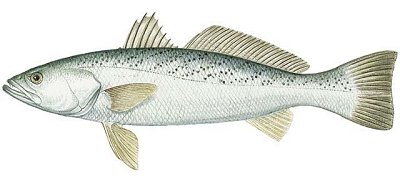Weakfish

Cynoscion regalis
Profile by John McClain Principal Fisheries Biologist
The Weakfish is a member of the croaker family. The family name is derived from the ability of the males to make a drumming or croaking noise.
Size:
to 36" and 18 lbs.
Common Names:
Weakfish, squeteague, trout, gray trout Scientific Name: Cynoscion regalis
Range:
Massachusetts Bay to southern Florida Food: Weakfish feed throughout the water column on a large variety of fishes and invertebrates, including butterfish, menhaden, thread herring, round herring, sandlance, silversides, mackerel, anchovy, shrimp, squid, crab, and worms.
Migration:
Weakfish migrate northward in the spring, spending the summer inshore. They move southward again in late autumn.
Habitat:
Usually found in shallow waters along open sandy shores and in large bays and estuaries, including salt marsh creeks and sometimes into river mouths, but never into freshwater.
Spawning:
Most weakfish are mature by the age of two. Spawning occurs in the nearshore and estuarine zones along the coast from May to October. The number of eggs produced is a function of size. Eggs are buoyant and float to the surface where they drift for one and one-half days until hatching.
Recreational and Commercial Importance:
Weakfish are one of the most important recreational and commercial fishes in waters from New York through North Carolina. Annual commercial landings of weakfish along the East Coast from the mid-1940s through 1994 ranged between 3.1 (1967) and 36 (1980) million pounds.
Weakfish are harvested commercially using pound nets, haul seines, gill nets and trawls, and hook & line during spring, summer and fall. During the winter they are taken in trawls, gill nets, and fly nets, primarily off the North Carolina coast.
Historically, the greatest landings were in the mid-Atlantic and Chesapeake Bay. Before 1957, Virginia and New Jersey accounted for most landings of weakfish. Between 1957 and 1975, North Carolina consistently landed the most weakfish of the Atlantic coast, but Virginia and New Jersey also landed a significant portion of the coast-wide total. After 1976, North Carolina has dominated coast-wide landings, landing between one-third and two-thirds of the coast-wide total.
Recreationally, weakfish are viewed as strong fighters and as a desirable fish for consumption that are available inshore. The recreational catch occurs primarily from private and rental boats, and also party and charter boats and shore-based angling. Recreational landings have ranged from an estimated 960,000 fish in 1992 to a high of 9,344,000 fish in 1981.
At times weakfish are very fussy eaters and will be taken only certain baits. One of the most effective methods in shallow bay waters is to chum with live grass shrimp. Place two shrimp on a number 10 or 12 hook and let the bait drift back in the slick. This method will work from a boat or the bank. Another reliable method is to cast and retrieve a bucktail tipped with squid or shedder crab across creek mouths and along sod banks. In the surf, still fishing with cut bait or live spot or snappers is an old standby; casting with plugs, spoons, and bucktails will also produce results. Weakfish can be taken in near-shore ocean waters between May and November. Two of the most often used methods are jigging with spoons, bucktails or tube lures and drifting top and bottom rigs baited with squid or fish strips.
Acknowledgments and References:
Fishery Management Report No. 27 of the Atlantic States Marine Fisheries Commission
This article first appeared in New Jersey Fish & Wildlife Digest - 2002 Marine edition

